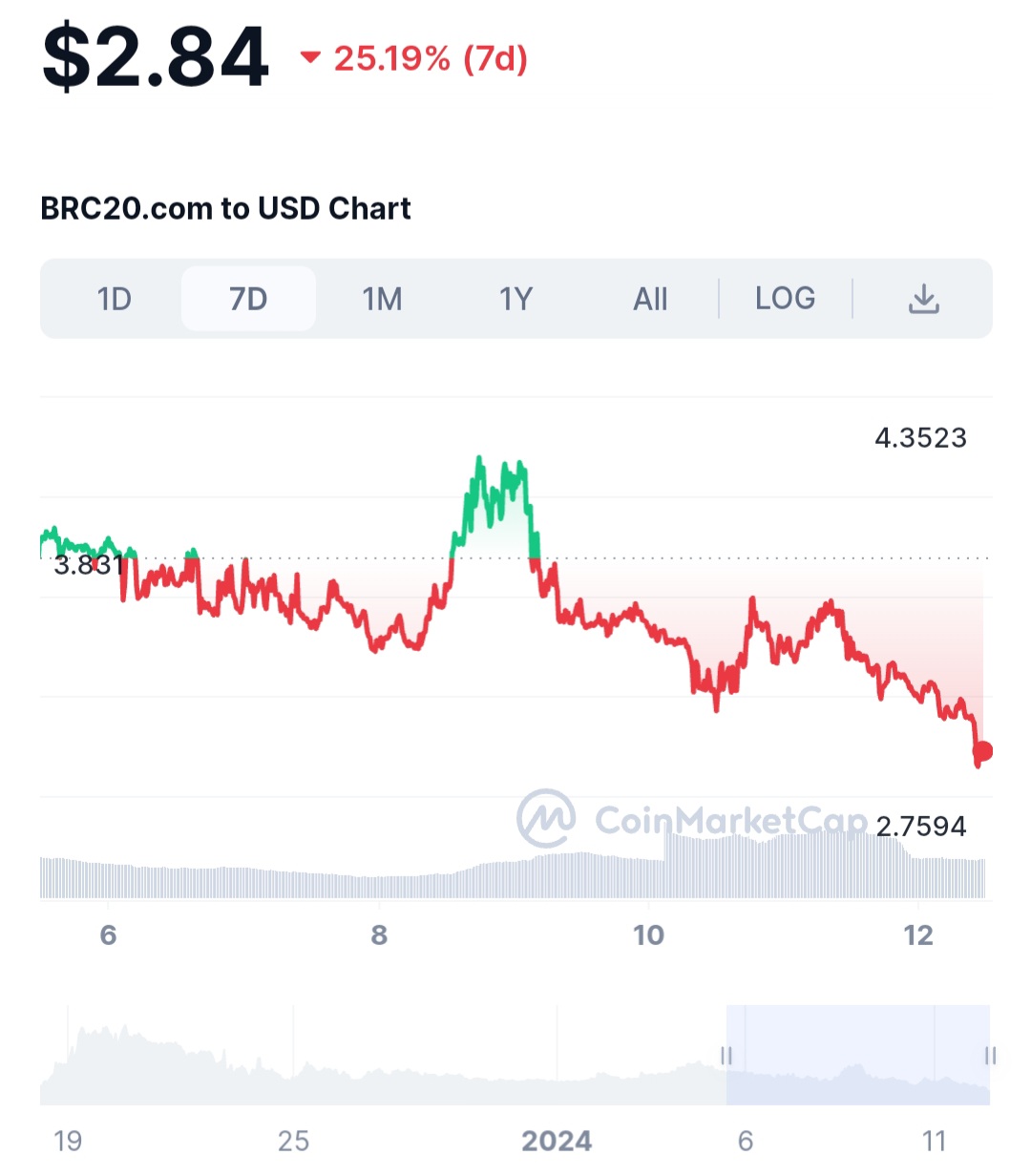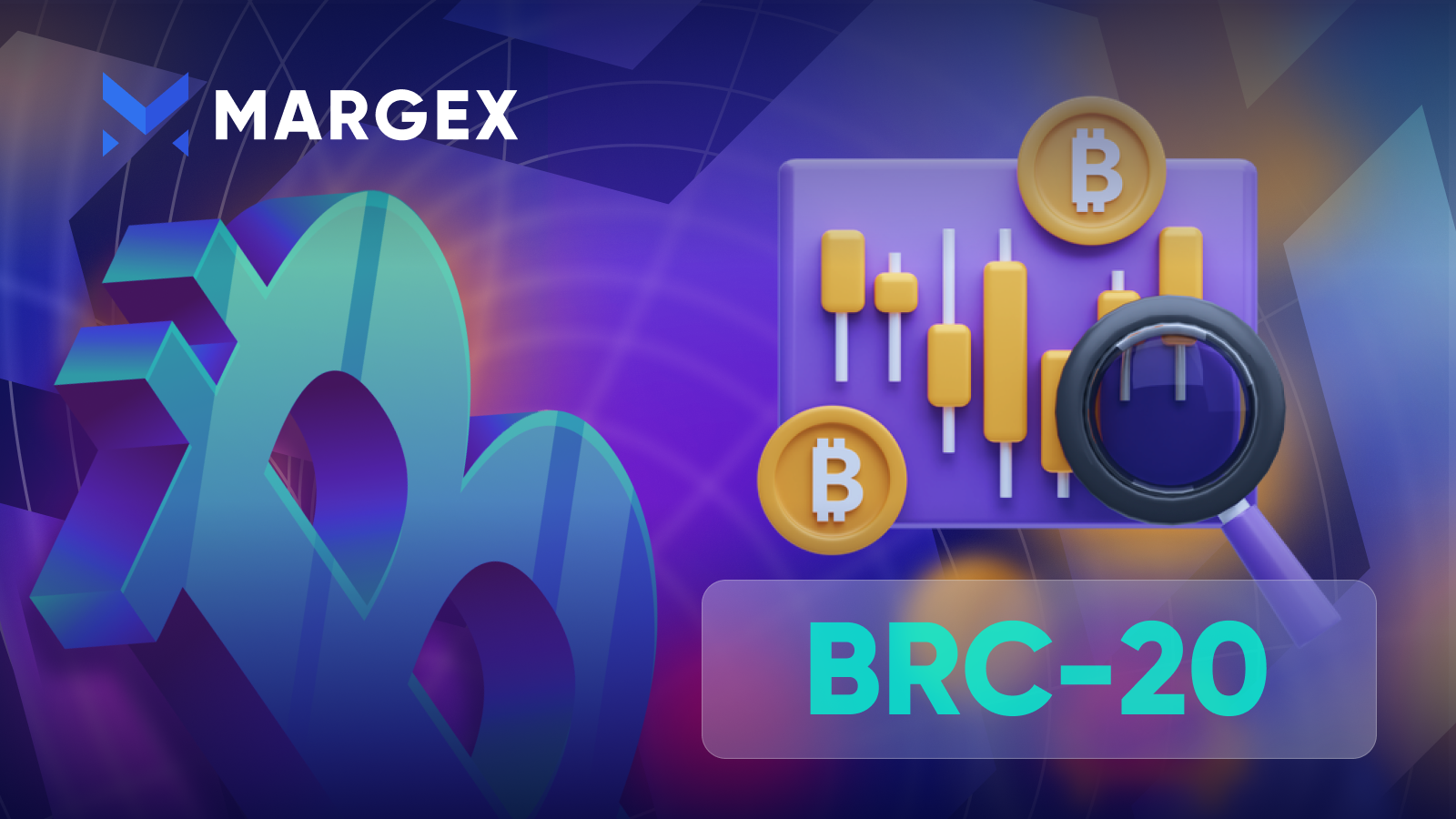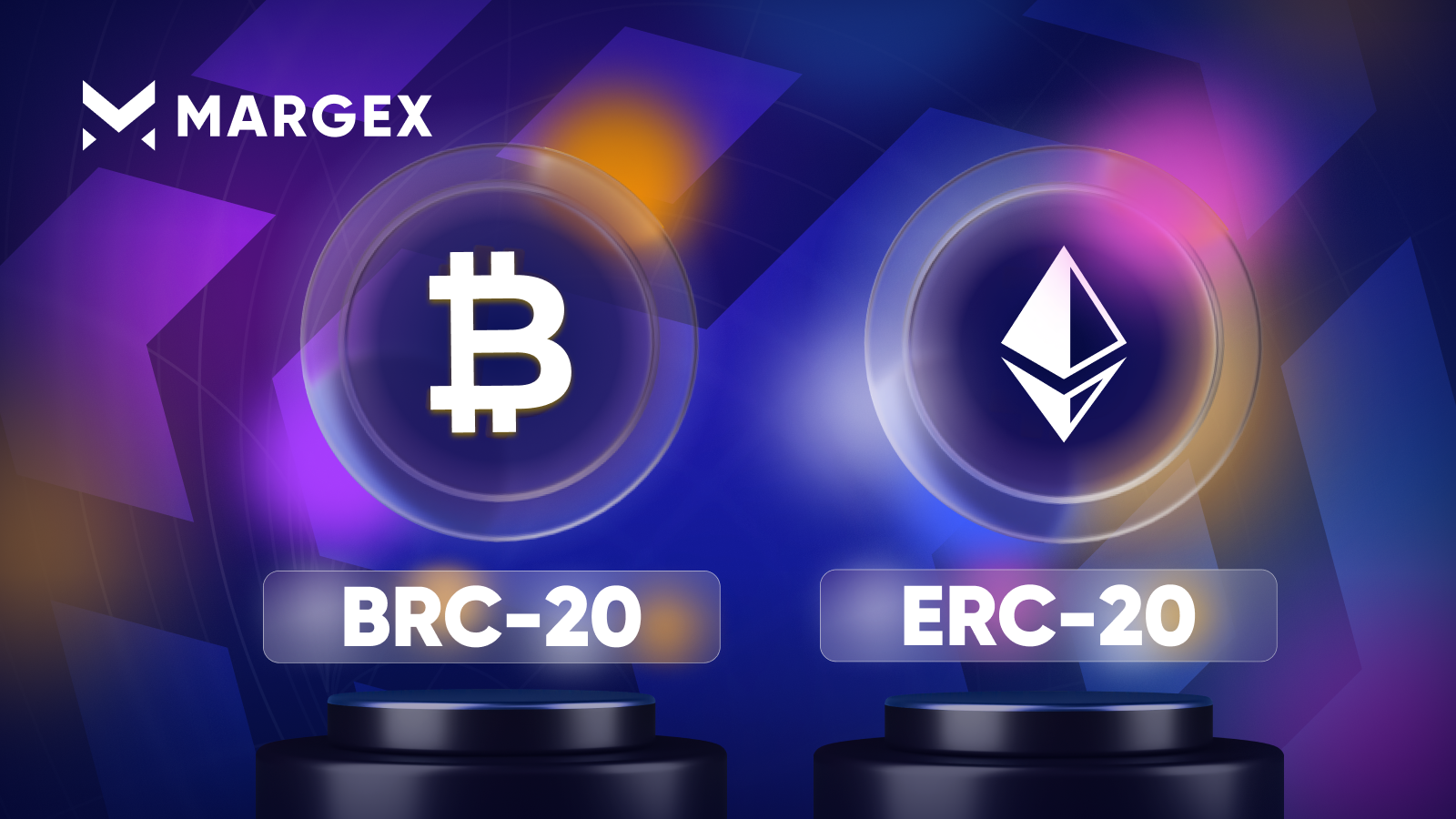
What is a BRC-20 Token?
BRC-20 tokens leverage ordinal inscription and constitute an experimental token standard. They were introduced to the market by an anonymous developer, Domo, on March 9, 2023. These tokens are native to Bitcoin and are fungible. Interestingly, unlike popular token standards on EVM chains, the BRC-20 standard does not rely on smart contracts.
Instead, it enables users to store a script file on Bitcoin and use it to associate tokens with specific satoshis. To deploy, mint, and transfer tokens, users can employ BRC-20 tokens, which incorporate JSON data in ordinal inscriptions. This unique approach has captured the attention of the crypto community, promoting adoption and exploration of new possibilities in the cryptocurrency space.
Last 7 days, the price of the BRC-20 Token is trading at:

Practical Applications of BRC-20 Tokens
Peer-to-peer Transfers:The most essential function of BRC-20 tokens is to facilitate value transfers from person to person. These tokens leverage Bitcoin’s functionality and can move between different wallets, regardless of their location. The efficiency of Bitcoins translates to BRC-20 tokens, and transaction fees are charged natively in Bitcoin.
Decentralized Finance (DeFi): Although decentralized finance (DeFi) systems have reached notable heights on Ethereum and EVM networks, the advent of BRC-20 could mark the beginning of DeFi’s foray into the Bitcoin network. Unlike Bitcoin, the flexibility of BRC-20 allows it to seamlessly integrate into DeFi protocols.
Implementation: BRC-20 tokens can be integrated into decentralized exchanges (DEX), yield farms, and other lending protocols. Platforms like Ordinalwallets.com have already established a foundation for transferring, trading, and minting BRC-20 and Bitcoin NFTs. The ongoing development of similar platforms promises a snowball effect as BRC-20 advances in the DeFi space. These use cases highlight the versatility of BRC-20 tokens, from everyday transactions to their pivotal role in evolving decentralized finance on the Bitcoin network. The ability to seamlessly integrate into various protocols and its inherent connection with Bitcoin position BRC-20 tokens as a transformative force in the cryptocurrency landscape.
How BRC-20 Tokens Work

To understand the functionality of BRC-20 tokens, it’s crucial to delve into the workings of Bitcoin Ordinals. The Ordinals protocol establishes a systematic method for numbering satoshis, allowing users to attach additional data to these satoshis through a process known as “inscription.” BRC-20 tokens leverage Ordinals inscriptions, using JSON (JavaScript Object Notation) data to execute functions such as deploying token contracts, minting, and transferring tokens.
Currently, the BRC-20 token standard supports essential functions, including creating a BRC-20 token using the deploy function, minting a specific amount of BRC-20 tokens with the mint function, and transferring a designated amount of BRC-20 tokens using the transfer function. It’s important to note that the BRC-20 token standard is relatively new, and the procedures for deploying, minting, and transferring BRC-20 tokens may not be as intuitive compared to more established standards. Additionally, there are limited tools and supporting services specifically designed for BRC-20 tokens at this stage. As the ecosystem evolves, improvements in user-friendliness and the development of additional tools are expected to facilitate a smoother experience for those interacting with BRC-20 tokens.
Key Differences Between BRC-20 and ERC-20 Tokens

Despite the similarity in names, BRC-20 and ERC-20 tokens have fundamental differences in their structures and functionalities:
Smart Contracts:
ERC-20 (Ethereum): ERC-20 tokens on Ethereum operate through smart contracts, providing them with more versatile and autonomous management. They can self-manage for creating and issuing new tokens, maintain parallel subaccounting, and review user balances.
BRC-20 (Bitcoin): In contrast, BRC-20 tokens do not use smart contracts. Their functions are limited to minting and transferring tokens, making them considered more rudimentary and simple compared to ERC-20 counterparts.
Origin and Development:
ERC-20: ERC-20 tokens emerged as a proposal from Ethereum developers Fabian Vogelsteller and Vitalik Buterin, approved on November 19, 2015. They have been in the market for several years and are widely used by various companies, demonstrating broad interoperability in the ecosystem.
BRC-20: In contrast, BRC-20 tokens are relatively new and experimental. Their development does not involve the use of smart contracts, simplifying their structure. However, this novelty also means there are few platforms and wallets that support this technology compared to ERC-20.
Functional Complexity:
ERC-20: ERC-20 tokens offer advanced functions, such as the ability to burn or freeze tokens and program complex operations within smart contracts.
BRC-20: BRC-20 tokens lack these advanced functions. They cannot be burned, frozen, or programmed with complex operations, limiting their functionality compared to ERC-20 tokens.
Security:
ERC-20: In terms of security, ERC-20 tokens have extensive experience and have demonstrated their robustness in the market. They are used by many companies without significant security issues.
BRC-20: BRC-20 tokens, being a newer and experimental technology, have faced security challenges, including cases of double spending. However, they benefit from the inherent security of the Bitcoin network, considered one of the most secure in the cryptocurrency market.
Creating BRC-20 Tokens
Creating BRC-20 tokens involves carrying out an inscription process that defines key parameters of the token. Here is a step-by-step guide for those interested in embarking on this experience:
Define Token Parameters:
When creating a BRC-20 token, the creator decides how the issuance process of units will take place. They can choose to mint 100% of the supply upon deploying the contract or allow other users to mint a portion of the total supply. These decisions will impact how users interact with the token.
Interact with a Compatible Wallet:
For any interaction with BRC-20 tokens, it is essential to have a wallet that supports P2TR addresses and has the coin control feature (individual coin management). Examples of compatible wallets include Ordinals Wallet, Ordswap, and Unisat. Without these functions, there is a risk of losing tokens or inscriptions.
Consider Associated Costs:
You need to have Bitcoin funds in your wallet to cover inscription costs. Costs include the network fee paid to miners for processing the transaction. This fee varies depending on market demand at that time. If you use third-party services like UniSat to create BRC-20 tokens, you should also consider service fees.
Mint the Token:
Various services allow users to create inscriptions for BRC-20 tokens or contribute to the emissions of others. Platforms like Ordinalsbot, Unisat, and Ordswap offer markets to trade these assets. During this process, you will provide a Bitcoin address compatible with Ordinals (from your wallet) and pay an inscription fee calculated at that moment.
Wait for Verification:
BRC-20 tokens will only appear in users’ wallets when a miner confirms the block containing the asset. It is crucial to calculate fees correctly, as getting stuck in the network could result in the loss of the inscription, and services generally do not offer refunds.
Transformative Effect on the Cryptocurrency Market

The advent of BRC-20 tokens has left a significant mark on the ever-dynamic cryptocurrency market. By presenting a novel and cutting-edge perspective to harness blockchain technology, these tokens have captured the attention of both investors and users, creating a tangible impact.
As interest in cryptocurrencies grows, there is a rising demand for innovative projects and products capable of capitalizing on the power of blockchain technology. BRC-20 tokens, representing a pioneering way of using this technology, have quickly gained ground in this ever-evolving landscape. This impact is clearly manifested in the increasing number of projects and companies actively exploring this technology. A notable example is OrdSpace, a project that aggregates numerous BRC-20 tokens, including prominent projects like ORDI, $OG$, or PEPE.
The variety of listed BRC-20 tokens reflects the diversity and creativity in digital asset creation today. In fact, the figure of over 11,600 distinct tokens underscores the breadth of impact and interest in this innovative form of tokenization. The phenomenon is not insignificant. Take, for example, the case of ORDI, a project with less than a month of existence that already boasts an astonishing market capitalization of over 100 million dollars. Similarly, PEPE, the renowned Bitcoin memecoin, has its BRC-20 version and exhibits a capitalization of over 12 million dollars. In less than a month, these tokens have consolidated a global capitalization exceeding 160 million dollars.
Top Cryptocurrencies Using BRC-20 Tokens

The proliferation of BRC-20 tokens has led to the creation of more than 20,000 tokens in a matter of a few months. However, as is common in the world of altcoins, only a few projects launched on the Bitcoin network have gained notoriety and popularity. Interestingly, the prominent players in this new wave of tokens are memecoins, a category encompassing digital assets born from jokes or memes. A term resonating in the crypto community, backed by the virality and inherent humor of these cryptocurrencies. A noteworthy example of this phenomenon is:
Dogecoin (DOGE). Here is a list of some of the most famous BRC-20 tokens:
Ordi (ORDI): Represents a tokenization of the protocol where some Bitcoin NFTs, known as Ordinals, are issued.
Pepe (PEPE): Inspired by the famous bitcoiner meme and the early NFTs on the network, Rare Pepe.
Meme (MEME): Another memecoin that has captured the attention of investors, showcasing the appeal of culture and humor in the crypto space.
Domo (DOMO): Named after the creator of the BRC-20 standard, Twitter user @domodata, and has gained recognition in the community. These tokens not only represent digital assets but also encapsulate the creativity and diversity of approaches that characterize the world of BRC-20 standard-based cryptocurrencies.
Future of BRC-20 Token
The outlook for the BRC-20 token in the future is inherently speculative, as its evolution will depend on various factors, including adoption, security, innovation, and acceptance in the cryptocurrency ecosystem. Here are some possible directions that could shape the future of the BRC-20 token:
Increased Adoption and Infrastructure Development:
As more developers and projects adopt and use the BRC-20 standard, it’s likely that a more robust and user-friendly infrastructure will be developed. This could involve new tools, wallets, and services that facilitate the creation, management, and transaction of BRC-20 tokens.
Integration into Decentralized Finance (DeFi) Projects:
Given the versatility of BRC-20 tokens on the Bitcoin network, they could find significant applications in decentralized finance (DeFi) projects. Their ability to integrate into decentralized exchanges (DEX), yield farming, and other protocols could open new opportunities in Bitcoin’s DeFi space.
Continuous Innovation and New Use Cases:
Developers may continue to innovate and explore new use cases for BRC-20 tokens. The community might devise additional functionalities, security enhancements, and specific applications that expand the utility and demand for these tokens.
Improved Usability and Security:
Over time, the usability of BRC-20 tokens is expected to improve. This could involve more intuitive user interfaces, secure protocols, and best practices to ensure the integrity of transactions and asset custody.
Regulatory Responses:
How regulators address BRC-20 tokens and other cryptocurrencies will play a crucial role in their future. Regulatory clarity could encourage greater institutional and individual user adoption.
Challenges and Continuous Learning:
Since BRC-20 tokens are an experimental technology, they are likely to face challenges along the way. The community will learn from these challenges, iterate on the technology, and seek solutions to enhance the robustness and reliability of BRC-20 tokens.
In summary, the future of the BRC-20 token will depend largely on how the community of developers, users, and the overall cryptocurrency ecosystem respond and evolve around this innovative technology on the Bitcoin network.


